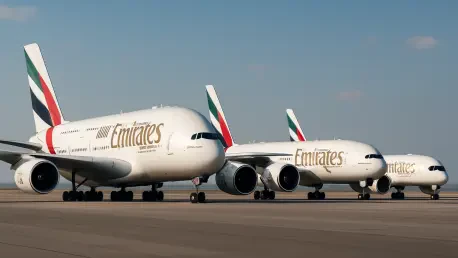In an era where global air travel demand is surging past pre-pandemic levels, with passenger numbers projected to hit 4.7 billion annually by 2030, Emirates has emerged as a frontrunner in redefining industry standards. At the Dubai Airshow this year, the airline unveiled a series of strategic initiatives that not only address current market pressures but also position it as a pacesetter for the next decade. This market analysis delves into the implications of Emirates’ $38 billion fleet expansion, groundbreaking inflight connectivity upgrades, and targeted network growth in emerging regions. By dissecting these moves, the aim is to uncover how they reflect broader aviation trends, influence competitive dynamics, and shape future passenger expectations in a rapidly evolving sector.
Unpacking Market Trends and Strategic Developments
Fleet Expansion: A Bet on Capacity and Efficiency
Emirates’ announcement of a $38 billion order for 65 additional Boeing 777-9 aircraft, expanding its Boeing 777X order book to 270 units, signals a robust response to escalating air traffic and airport capacity constraints. This investment, which includes 540 GE9X engines, reinforces the airline’s status as the largest operator of Boeing 777 aircraft while prioritizing fuel efficiency and operational scalability. The deal, with deliveries slated to begin in Q2 2027, also includes options to pivot toward the proposed Boeing 777-10 or 777-8 models, showcasing flexibility in adapting to future demand patterns. From a market perspective, this move aligns with an industry shift toward larger, more efficient widebody aircraft, as carriers grapple with slot limitations at major hubs and rising sustainability pressures.
The broader implications of this fleet renewal extend to competitive positioning and economic impact. By maintaining one of the youngest fleets in the sky, Emirates can reduce maintenance costs and appeal to environmentally conscious travelers, a growing demographic. Additionally, the order supports thousands of aerospace jobs in the U.S., strengthening bilateral trade ties while potentially pressuring competitors to accelerate their own modernization plans. However, risks such as production delays at Boeing could disrupt timelines, a factor that market analysts must monitor closely as it may affect Emirates’ ability to meet projected demand growth by the end of the decade.
Inflight Connectivity: Redefining Passenger Expectations
Another pivotal announcement was Emirates’ rollout of Starlink high-speed internet across 232 of its Boeing 777 and Airbus A380 aircraft, creating the largest Starlink-enabled widebody fleet globally. Unlike traditional inflight Wi-Fi, which often comes with speed caps and fees, this service offers free, unrestricted access for streaming, gaming, and video calls to passengers across all cabin classes. With installations progressing at a rate of 14 aircraft per month, this initiative taps into a critical market trend: the rising expectation for seamless digital experiences at 30,000 feet, mirroring ground-based connectivity standards.
From a competitive standpoint, this positions Emirates ahead of many rivals who still charge for limited bandwidth or restrict access to premium cabins. Market data suggests that over 60% of passengers now prioritize inflight internet availability when choosing airlines, making this a potential game-changer for customer loyalty. Challenges remain, including regulatory hurdles across different regions and the scalability of satellite technology under high demand. Nonetheless, this bold step could force industry peers to rethink their connectivity offerings, potentially accelerating a race toward universal, high-speed inflight internet as a baseline service rather than a luxury.
Network Growth: Targeting Emerging Markets
Emirates also revealed plans for a third daily flight to Nairobi, Kenya, starting March 1, 2026, increasing weekly frequencies to 21 and marking 30 years of service to the region. This expansion aligns with Kenya’s ambition to attract 5 million international visitors by 2030 and leverages a recent economic partnership agreement with the UAE to boost trade and tourism. The early morning schedule enhances connectivity for key markets like the UK, France, and the US, while an interline agreement with Kenya Airways facilitates regional access, catering to over 6.6 million passengers historically served on this route.
This strategic focus on Africa reflects a wider industry trend of targeting high-growth emerging markets, where air travel demand is projected to rise by 6% annually through 2035, outpacing more saturated regions. Emirates’ move not only strengthens its foothold in East Africa but also highlights the importance of tailored scheduling and partnerships in capturing market share. Yet, competition from other carriers and geopolitical uncertainties in the region could pose challenges, requiring careful navigation to sustain profitability. For now, this expansion underscores a nuanced approach to balancing global reach with localized opportunities.
Future Projections: Shaping Aviation’s Trajectory
Looking ahead, Emirates’ initiatives point to several transformative trends likely to define the aviation market. The push for larger aircraft like the Boeing 777X series addresses the dual need for capacity and fuel efficiency, potentially setting a precedent for fleet strategies industry-wide as passenger volumes climb. Support for innovations such as the proposed 777-10 variant hints at even greater solutions for congested hubs, a critical consideration as major airports near operational limits. Market forecasts indicate that by 2030, over 40% of new aircraft deliveries will prioritize efficiency metrics, a shift Emirates is spearheading with its current orders.
On the technology front, the Starlink rollout could redefine inflight connectivity as a non-negotiable feature, with analysts predicting that by 2028, nearly 70% of global fleets will offer high-speed internet to remain competitive. This trend may pressure smaller carriers to partner with tech providers or risk losing market relevance. Meanwhile, expansion into regions like Nairobi signals Africa’s growing role as a focal point for aviation growth, with investment in infrastructure and tourism expected to drive demand. Regulatory changes and economic fluctuations could influence these projections, but Emirates’ substantial investments suggest a strong likelihood of maintaining leadership in setting industry benchmarks through at least the next five years.
Reflecting on Strategic Insights and Next Steps
Looking back, Emirates’ announcements at the Dubai Airshow crystallized a vision of leadership through innovation, capacity, and market expansion. The fleet investment highlighted a commitment to efficiency that addressed both operational and environmental challenges, while the connectivity upgrade redefined passenger experience standards. The focus on Nairobi underscored the potential of untapped markets to fuel long-term growth. Moving forward, industry stakeholders should consider accelerating digital transformation by exploring partnerships with technology firms like SpaceX to enhance customer offerings. Additionally, airlines might benefit from strategic alliances with regional tourism boards to unlock emerging destinations. For Emirates, continuing to balance bold investments with risk mitigation around delivery timelines and geopolitical factors will be crucial. These steps, if executed well, could ensure that the aviation sector evolves into a more connected, efficient, and accessible space for global travelers.









